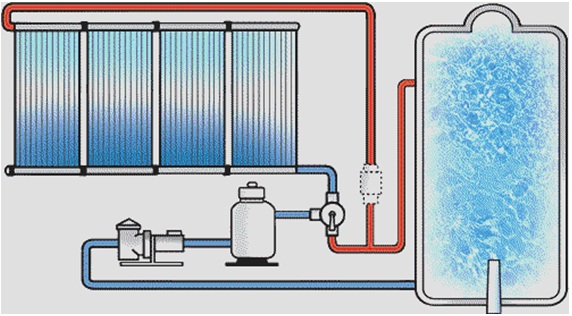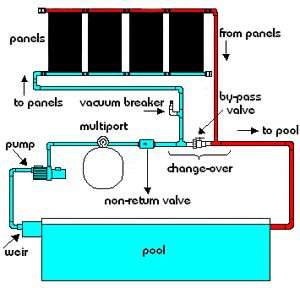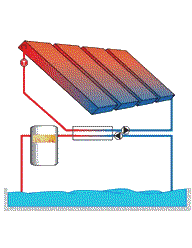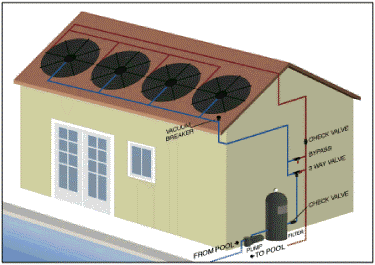|
|
|
 We Turn Sunlight Into Power
We Turn Sunlight Into Power
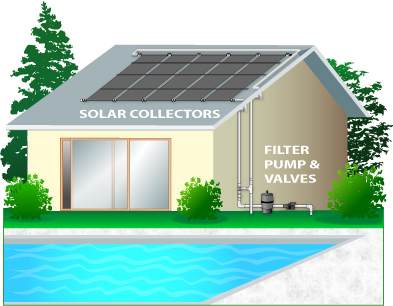
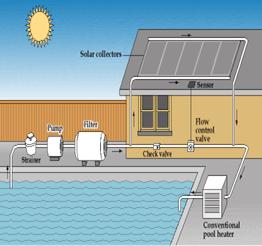
Solar Pool Heating is one of the simplest and the most cost-effective use of solar energy. You can significantly ensure warmer pool temperature with no monthly heating bills.
By installing the Solar Pool Heater, you can enjoy free heating for your pool, and is proven to be the most cost effective way to heat your pool, you only have to look up to realize the primary benefit of solar heat - it's free heat from the sun! With uncertainty and rising costs in the power markets, the price for solar will not change. It will be free for life.
. Most solar pool heating systems include the following:
Solar Collector: The device through which pool water is circulated to be heated by the sun
Filter: Removes debris before water is pumped through the collector.
Pump: Circulates water through the filter and collector and back to the pool.
Flow Control Valve: Automatic or manual device that diverts pool water through the solar collector.

Pool water is pumped using your existing pool pump The sun's rays heat the water in the panels (solar collectors) then the heated water is returned to your pool, the collector(s) can also be used to cool the pool during peak summer months by circulating the water through the collector(s) at night.
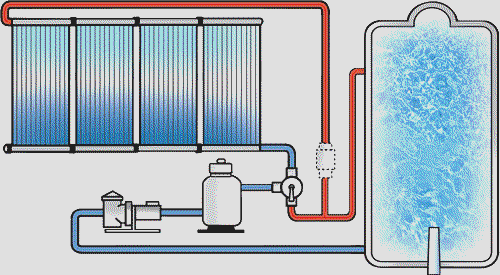
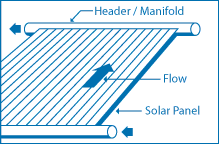

Some systems include sensors and an automatic or manual valve to divert water through the collector(s) when the collector temperature is sufficiently greater than the pool temperature. When the collector temperature is similar to the pool temperature, filtered water simply bypasses the collector(s) and is returned to the pool.
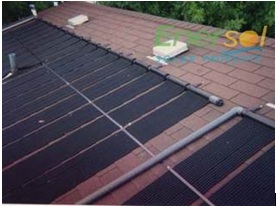
Solar pool collectors are made out of different materials (Glazed/Unglazed Collectors), the unglazed solar pool heating collectors are ideal at our region climate. Unglazed collectors are generally made of heavy-duty rubber or plastic treated with an ultraviolet (UV) light inhibitor to extend the life of the panels. These unglazed systems can even work for indoor pools in cold climates if the system is designed to drain back to the pool when not in use.
An unglazed solar pool heating system usually costs between $3,000 and $4,000 to buy and install. This provides a payback of between 1.5 and 7 years, depending on your local fuel costs. They also typically last longer than gas and heat pump pool heaters. Your actual cost and payback depend on many factors. Therefore, before you purchase and install a solar pool heating system, you should do the following:
Evaluate your site's solar resource
Determine the correct system size
Determine the system's efficiency
Compare system costs
Investigate local codes, covenants, and regulations
The proper installation of a solar pool heating system depends on many factors. These factors include solar resource, climate, local building code requirements, and safety issues. Therefore, it's best to have a qualified solar thermal systems contractor install your system.
After installation, properly maintaining your system will keep it running smoothly for 10–20 years. Consult your contractor and read your owner's manual for maintenance requirements. Your collector should require little maintenance if the pool's chemical balance and filtering system are checked regularly. Glazed collectors may need to be cleaned in dry climates where rainwater doesn't provide a natural rinse.
Extend swimming season up to 12 months.
Zero operating costs.
No pollution, no fuel needed.
Quick & Simple one day installation.
10 Years Warranty.
Water Temperature exceeding 26º.
Minimal maintenance required.
Measure the overall length and width of the pool. Refer to Table 1 for Shape Multipliers.
Overall Length _____Ft X Overall Width _____Ft X Shape Multiplier _____ = (A). _____ SqFt
(Alternate method: Pool Gallons / 7.48 / Average Depth = Pool SqFt)
Shape |
Mult. |
Rectangle |
1.00 |
Kidney/Freeform |
0.85 |
Oval |
0.90 |
Round |
0.79 |
Check the orientation of the roof area with a compass, refer to Table 2 and select an Orientation Multiplier. Solar panels can face up to 30° East or West of True South for optimum efficiency. Panels cannot face in a northerly direction, unless supported by a rack to elevate the system towards south.
Orientation |
Mult. |
South Facing |
1.00 |
East or West Facing |
1.25 |
Flat |
1.10 |
(B). _______
Determine the percentage of shade on the entire pool during the Solar Day (9 am - 5 pm), refer to Table 3 and select a Shade Multiplier. If only a portion of the pool is shaded for part of the solar day, then a Shade Multiplier should be extrapolated from the table (i.e. 50% of the pool shaded for 50% (4 hours) of the solar day equals 25% or a multiplier of 1.10). Indoor pools should use 100% shade multiplier.
Orientation |
Mult. |
No Shade from 9 a.m. to 5 p.m. |
1.00 |
25% Shade |
1.10 |
50% Shade |
1.25 |
75% Shade |
1.50 |
100% Shade |
1.75 |
(C). _______
If the pool has a screen enclosure, use a Screen Multiplier of 1.25
If the pool does not have a screen enclosure, use a Multiplier of 1.0
(D). _______
(E). _______
| Region | 9 - 10 Month | 11 - 12 Month |
North Florida |
0.64 |
0.80 |
Central Florida |
0.56 |
0.68 |
South Florida |
0.48 |
0.56 |
(F). _______
Sq. footage (F) from above: _______
div. by 32 = ___ 4Ft X 8Ft Panels
or div. by 40 = ___ 4Ft X 10Ft Panels
or div. by 48 = ___ 4Ft X 12Ft Panels
Some roof configurations may require combining several sizes of panels to achieve the total square footage. See the Solar Pool Heater
Installation Manual for details.
Sizing guidelines assume use of a pool cover when night time temperatures are below 60 degrees. If a cover is not used during these conditions, the system must be over-sized by 75 to 100%. For
assistance with proper sizing or design,
